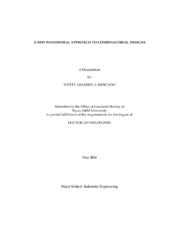| dc.description.abstract | We consider combinatorial t-design problems as discrete optimization problems. Our motivation is that only a few studies have been done on the use of exact optimization techniques in designs, and that classical methods in design theory have still left many open existence questions. Roughly defined, t-designs are pairs of discrete sets that are related following some strict properties of size, balance, and replication. These highly structured relationships provide optimal solutions to a variety of problems in computer science like error-correcting codes, secure communications, network interconnection, design of hardware; and are applicable to other areas like statistics, scheduling, games, among others. We give a new approach to combinatorial t-designs that is useful in constructing t-designs by polyhedral methods. The first contribution of our work is a new result of equivalence of t-design problems with a graph theory problem. This equivalence leads to a novel integer programming formulation for t-designs, which we call GDP. We analyze the polyhedral properties of GDP and conclude, among other results, the associated polyhedron dimension. We generate new classes of valid inequalities to aim at approximating this integer program by a linear program that has the same optimal solution. Some new classes of valid inequalities are generated as Chv´atal-Gomory cuts, other classes are generated by graph complements and combinatorial arguments, and others are generated by the use of incidence substructures in a t-design. In particular, we found a class of valid inequalities that we call stable-set class that represents an alternative graph equivalence for the problem of finding a t-design. We analyze and give results on the strength of these new classes of valid inequalities. We propose a separation problem and give its integer programming formulation as a maximum (or minimum) edge-weight biclique subgraph problem. We implement a pure cutting-plane algorithm using one of the stronger classes of valid inequalities derived. Several instances of t-designs were solved efficiently by this algorithm at the root node of the search tree. Also, we implement a branch-and-cut algorithm and solve several instances of 2-designs trying different base formulations. Computational results are included. | en |


